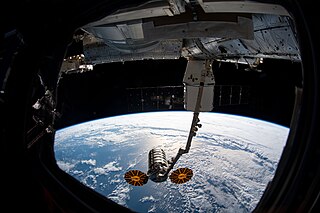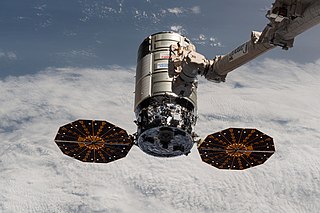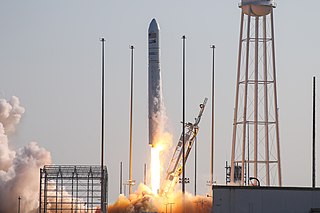RAIKO is a Japanese satellite which was built and operated by Tohoku and Wakayama Universities. A two-unit CubeSat, RAIKO was deployed from the International Space Station (ISS) on 4 October 2012, having been launched on 21 July 2012.

Antares, known during early development as Taurus II, is an expendable launch system developed by Orbital Sciences Corporation and the Pivdenne Design Bureau to launch the Cygnus spacecraft to the International Space Station as part of NASA's COTS and CRS programs. Able to launch payloads heavier than 8,000 kg (18,000 lb) into low Earth orbit, Antares is the largest rocket operated by Northrop Grumman. Antares launches from the Mid-Atlantic Regional Spaceport and made its inaugural flight on April 21, 2013. Antares 100 was retired in 2014 and series 200 was retired in 2023 due to component unavailability. As of January 2024 Antares 300 is under development.

Cygnus is an expendable American cargo spacecraft used for International Space Station (ISS) logistics missions. Cygnus was developed by Orbital Sciences Corporation, partially funded by NASA under the agency's Commercial Orbital Transportation Services (COTS) program. To create Cygnus, Orbital paired the Multi-Purpose Logistics Module, built by Thales Alenia Space and previously used by the Space Shuttle for ISS logistics, with a service module based on Orbital's GEOStar, a satellite bus. After a successful demonstration flight in 2013, Orbital was chosen to receive a Commercial Resupply Services (CRS) contract. A larger Enhanced Cygnus was introduced in 2015. Orbital Sciences was renamed Orbital ATK in 2015 and Northrop Grumman purchased Orbital in 2018 and has continued to operate Cygnus missions.

Commercial Resupply Services (CRS) are a series of flights awarded by NASA for the delivery of cargo and supplies to the International Space Station (ISS) on commercially operated spacecraft. The first CRS contracts were signed in 2008 and awarded $1.6 billion to SpaceX for twelve cargo Dragon and $1.9 billion to Orbital Sciences for eight Cygnus flights, covering deliveries to 2016. The Falcon 9 and Antares rockets were also developed under the CRS program to deliver cargo spacecraft to the ISS.

A space tug is a type of spacecraft used to transfer spaceborne cargo from one orbit to another orbit with different energy characteristics. The term can include expendable upper stages or spacecraft that are not necessarily a part of their launch vehicle. However, it can also refer to a spacecraft that transports payload already in space to another location in outer space, such as in the Space Transportation System concept. An example would be moving a spacecraft from a low Earth orbit (LEO) to a higher-energy orbit like a geostationary transfer orbit, a lunar transfer, or an escape trajectory.

This article documents notable spaceflight events during the year 2019.

This article documents notable spaceflight events during the year 2018. For the first time since 1990, more than 100 orbital launches were performed globally.

Nanoracks LLC is a private in-space services company which builds space hardware and in-space repurposing tools. The company also facilitates experiments and launches of CubeSats to Low Earth Orbit.

OA-4, previously known as Orbital-4, was the fourth successful flight of the Orbital ATK uncrewed resupply spacecraft Cygnus and its third flight to the International Space Station (ISS) under the Commercial Resupply Services (CRS-1) contract with NASA. With the Antares launch vehicle undergoing a redesign following its failure during the Orb-3 launch, OA-4 was launched by an Atlas V launch vehicle. Following three launch delays due to inclement weather beginning on 3 December 2015, OA-4 was launched at 21:44:57 UTC on 6 December 2015. With a liftoff weight of 7,492 kg (16,517 lb), OA-4 became the heaviest payload ever launched on an Atlas V. The spacecraft rendezvoused with and was berthed to the ISS on 9 December 2015. It was released on 19 February 2016 after 72 days at the International Space Station. Deorbit occurred on 20 February 2016 at approximately 16:00 UTC.

Diwata-1 also known as PHL-Microsat-1 was a Philippine microsatellite launched to the International Space Station (ISS) on March 23, 2016, and was deployed into orbit from the ISS on April 27, 2016. It was the first Philippine microsatellite and the first satellite built and designed by Filipinos. It was followed by Diwata-2, launched in 2018.

NG-10, previously known as OA-10E, is the eleventh flight of the Northrop Grumman uncrewed resupply spacecraft Cygnus and its tenth flight to the International Space Station under the Commercial Resupply Services (CRS-1) contract with NASA. The mission launched on 17 November 2018, at 09:01:31 UTC. This particular mission is part of an extension of the initial CRS contract that enables NASA to cover the ISS resupply needs until the Commercial Resupply Services-2 (CRS-2) contract enters in effect.

NG-11, previously known as OA-11, is the twelfth flight of the Northrop Grumman robotic resupply spacecraft Cygnus and its eleventh flight to the International Space Station under the Commercial Resupply Services (CRS-1) contract with NASA. The mission launched on 17 April 2019 at 20:46:07 UTC. This is the last mission from the extended CRS-1 contract; follow-up missions are part of the CRS-2 contract. Cygnus NG-11 was also the first mission to load critical hardware onto Cygnus within the last 24 hours prior to launch, a new Antares feature.

NG-13, previously known as OA-13, was the fourteenth flight of the Northrop Grumman robotic resupply spacecraft Cygnus and its thirteenth flight to the International Space Station (ISS) under the Commercial Resupply Services (CRS-1) contract with NASA. The mission launched on 15 February 2020 at 20:21:01 UTC after nearly a week of delays. This is the second launch of Cygnus under the CRS-2 contract.

NG-14, previously known as OA-14, was the fifteenth flight of the Northrop Grumman robotic resupply spacecraft Cygnus and its fourteenth flight to the International Space Station under the Commercial Resupply Services (CRS-1) contract with NASA. The mission was launched on 3 October 2020, at 01:16:14 UTC.

NG-15, previously known as OA-15, was the fifteenth launch of the Northrop Grumman robotic resupply spacecraft Cygnus and its fourteenth flight to the International Space Station (ISS) under the Commercial Resupply Services (CRS) contract with NASA. The mission launched on 20 February 2021 at 17:36:50 UTC. This is the fourth launch of Cygnus under the CRS-2 contract.

NG-16, previously known as OA-16, was the sixteenth flight of the Northrop Grumman robotic resupply spacecraft Cygnus and its fifteenth flight to the International Space Station (ISS) under the Commercial Resupply Services (CRS-2) contract with NASA. The mission was launched on 10 August 2021 at 22:01:05 UTC, for a (planned) 90-day mission at the ISS. This was the fifth launch of Cygnus under the CRS-2 contract.
Maya-2 was a Filipino nanosatellite. It succeeded Maya-1, the first Filipino nanosatellite, which was deorbited in November 2020.
GuaraníSat-1 was the first Paraguayan satellite. The nanosatellite's development was part of a collaboration between the Paraguayan Space Agency and the fourth Joint Global Multination Birds Satellite (Birds-4) multi-national project initiated by the Kyushu Institute of Technology of Japan.

NG-18 was the eighteenth flight of the Northrop Grumman robotic resupply spacecraft Cygnus and its seventeenth flight to the International Space Station (ISS) under the Commercial Resupply Services (CRS-2) contract with NASA. The mission successfully launched on 7 November 2022 at 10:32:42 UTC. This was the seventh launch of Cygnus under the CRS-2 contract.















